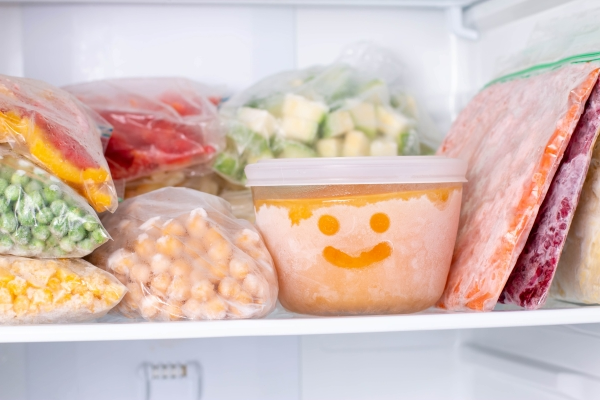Freezer Not Freezing: Troubleshooting Tips to Drop the Temp

When your freezer’s not cold enough, the food you’re storing can suffer and spoil. To avoid losing your frozen meats, veggies, and leftovers to the thaw, here are some troubleshooting tips to help keep things chilly and your food safe. However, if your frozen food does start to thaw, we recommend replacing it since there’s no way to tell if it’s still safe to eat.
Why Is My Freezer Not Freezing?
Freezers can lose their cool and go bad for a lot of reasons, so the first step is to figure out if it’s an easy fix or if you need to call an expert for freezer repair. Here are some of the most common reasons why your freezer may not be staying cold enough:
-
Dirty condenser coils. These coils are the main part of the cooling capacity in your freezer. When they get blocked or dirty, they lose effectiveness. Your condenser coils look like a series of coiled metal tubing, sometimes behind a metal mesh or a grate. If accessible, they should be in the freezer box, behind the cover at the back of your freezer. Luckily, cleaning the coils can fix the problem.
-
Malfunctioning evaporator fan. You need a functioning evaporator fan to circulate cool air to everything in the freezer. A broken motor can bring up the temperature in your appliance. The fan is located behind the back cover of your freezer, likely above or next to the condenser coils.
-
Broken start relay. The compressor moves the air through the freezer's warming and cooling functions, and the start relay powers the compressor. A broken relay can cause the whole air circulation system to shut down. Your appliance may be making a clicking sound while running if this is the case. This requires professional freezer part replacement.
-
Defective electronic controls. If you cannot find a problem with any of the freezer parts, the freezer may not be receiving power. Check your freezer’s settings to make sure “demo mode” is off. If the light doesn’t come on when you open the freezer door, check the outlet by plugging in something like a lamp or hairdryer. If the outlet and settings are fine, the electronic controls may have gone bad. If the electrical outlet is causing your freezer problems, reach out to an experienced local electrician.
-
Faulty defrost thermostat. When the contacts on a defrost thermostat stop working, the freezer can’t tell how cold or warm it is. If the freezer temperature is set correctly and you don’t see excessive frost that could be blocking air flow, the thermostat likely needs to be replaced.
Related Topic: How Long Do Freezers Last?
Further Freezer Troubleshooting
Don’t worry if you don’t want to reach for the phone right away. It’s an option to run a few checks on your freezer first. Depending on what’s wrong, some troubleshooting steps can be dangerous if you aren’t trained, so take precautions before proceeding (e.g., unplug the unit!) and contact an expert when troubleshooting goes beyond your expertise and comfort level.
-
The freezer’s not working, but the fridge is. If your fridge is cold but your freezer is warm, you know that the whole appliance isn’t broken. A part of the freezer is to blame for the malfunction. Try troubleshooting the problem in this order: Double-check your freezer settings. Clean your condenser coils. Check if the evaporator fan runs by opening the door, then holding down the door switch to trick the freezer into thinking it’s shut. Then test the start relay with a multimeter.
-
How to make your freezer colder. Control the temperature settings of your freezer via the temperature control thermostat. Check that it’s functioning by rotating it from the lowest setting to the highest setting. If the thermostat doesn’t click when it hits the highest setting, it’s likely defective. Check that the defrost thermostat, which is connected to the condenser coils, is fully clear of buildup and frost. Brush it off if necessary.
-
Freezer has power but isn’t running. Especially if your freezer is new, make sure all the demo settings are off and your freezer is set to run as normal. If the fridge has power, the problem may lie in your freezer’s electronic systems. These are best replaced by an expert technician.
-
Only one part of the freezer is freezing. The most likely cause of a partial freeze, or “cool zones,” is a sealed system leak. You may also see one part of the evaporator coil frosting over while the rest seems fine. If this happens, it may be most cost-effective to replace the entire appliance.
-
Chest freezer not working. Chest freezers often stop working for many of the same reasons that standing freezers do. Check the settings, compressor, condenser coils, evaporator fan, defrost thermostat, and power supply for issues as you would in an upright freezer. You’ll also need to check the lid gasket to ensure it seals properly when closed. If part of the seal is broken or weak, you’ll need the whole gasket to be replaced.
If your freezer overcorrects and starts frosting over, learn how to handle frost buildup in your freezer.
When At-Home Tinkering Isn’t Enough
A freezer that is not staying cold enough is not only an inconvenience, it can also be costly when your food continues to spoil. Whether you think you’ve found the problem, or you’re still stumped, the most efficient next step is to have an expert confirm the freezer issue and fix it fast. Your local Mr. Appliance has the parts and expertise to fix your faulty freezer so you can store your frozen foods safely. Schedule an appointment online today.
 Click to call
Click to call


